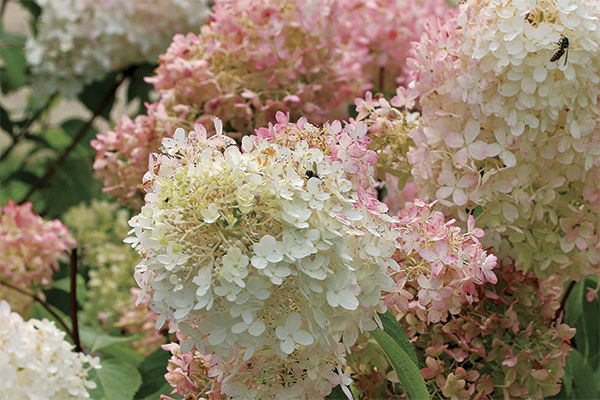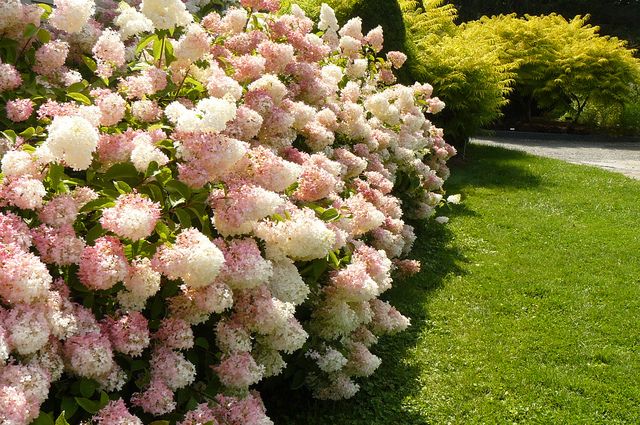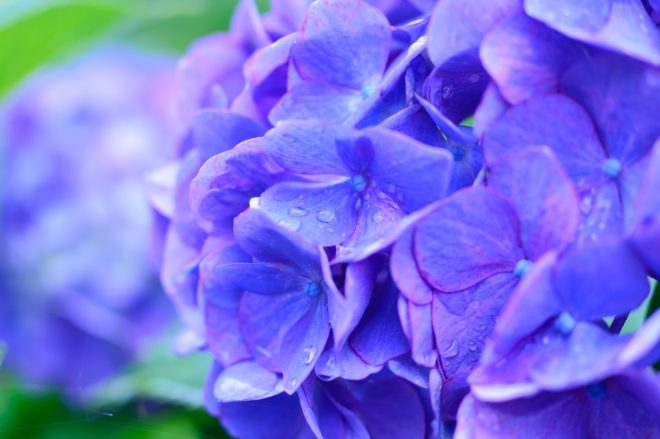Find out which panicle varieties are so amazing, you’ll never want to plant a bigleaf type again.

There is no denying the wow factor of the panicle hydrangea, especially when it’s in bloom. The flower trusses are in-your-face big, averaging 15-20cm long, but they can be much bigger. Even better is that the robust blooms sit atop stout branches during the dog days of summer, when other shrubs have finished their show. Panicle hydrangea (Hydrangea paniculata) is a great old-fashioned shrub. I’ve seen a countless number of different panicle hydrangeas — a testament to their reliability and popularity.
Panicle hydrangea is undergoing a renaissance of sorts, with a plethora of fresh cultivars making this vintage shrub relevant again. The influx of new cultivars in the 1990’s, as well as the obvious similarity among some cultivars, fueled my interest. Let’s be honest, comparing the flowers can be like staring at a Magic Eye stereogram and waiting for the hidden image to appear. How distinct are the plants, really? Are the new cultivars improvements over the old ones or just more of the same?
The Top-Performing Panicles

 ‘Big Ben’ ‘Angel’s blush ‘
‘Big Ben’ ‘Angel’s blush ‘
Because of its name, you would expect ‘Big Ben’ to have huge flowers, but they are fairly average compared with those of other cultivars. However, the unexpected transformation of the blooms from creamy white to deep fuchsia is amazing. The color of the open, lacy panicles continue to get better with age, a rarity in the plant world.
Where ‘Big Ben’ is a bit of a misnomer, ‘Angel’s Blush’ (‘Ruby’) is a name that is spot-on. The deep red stems foreshadow what’s in store for the color of the blossoms, the white florets blush pink come mid-summer and then gradually darken to red by mid-autumn.
 ‘Dharuma’ is one of the earliest hydrangeas to bloom at the start of summer and is one of the smallest of the hydrangeas, making it perfect for undersize gardens or containers. It holds on beautiful red stems, the diminutive, lacy white flowers eventually age to deep pink. Because of its slow-growing, compact habit, this cultivar needs only a light pruning in spring to remove spent flowers.
‘Dharuma’ is one of the earliest hydrangeas to bloom at the start of summer and is one of the smallest of the hydrangeas, making it perfect for undersize gardens or containers. It holds on beautiful red stems, the diminutive, lacy white flowers eventually age to deep pink. Because of its slow-growing, compact habit, this cultivar needs only a light pruning in spring to remove spent flowers.

 ‘Limelight’ ‘Quick Fire’
‘Limelight’ ‘Quick Fire’
It’s evident that there is something special about ‘Limelight’ (‘Zwijnenburg’). The fresh chartreuse color and Rubenesque plumpness of its flower clusters sets it apart. I am still in awe of its bodacious floral show and beyond impressed that its stems are strong enough to hold up the rotund blossoms. In the garden, the serendipitous floral juxtaposition of overstuffed ‘Limelight’ with noble ‘Big Ben’ seems like a brilliant combination.
‘Quick Fire’ (‘Bulk’) is aptly named for how rapidly the white flowers change to pink in mid-summer, peaking at a dusky rose by late summer. Like ‘Dharuma’, which is one of its parents, ‘Quick Fire’ boasts deep red stems and an early bloom time. While it has a compact habit, it has vertical stems that occasionally shoot up arrow-straight in summer. The natural inclination is to prune back these errant stems, but resist the urge because they bear late-season flowers. Panicle hydrangeas typically have handsome, dark green leaves with no significant autumn colour, but the leaves of ‘Quick Fire’ turn orange when cooler temperatures set in.
 ‘Little Lamb’ looks like the kid brother of ‘Limelight’ but with creamy white flowers. Its plump panicles are jam-packed with the smallest florets of all, which are less than 1.5cm wide. I’ll fight the urge to compare the fluffy flowers to frolicking lambs, but the analogy is an honest one. Like ‘Limelight’, its showy florets gradually turn pink by early fall.
‘Little Lamb’ looks like the kid brother of ‘Limelight’ but with creamy white flowers. Its plump panicles are jam-packed with the smallest florets of all, which are less than 1.5cm wide. I’ll fight the urge to compare the fluffy flowers to frolicking lambs, but the analogy is an honest one. Like ‘Limelight’, its showy florets gradually turn pink by early fall.
 ‘Unique’ is a giant — the tallest cultivar with the largest flower trusses. I think of this cultivar as a garden classic (which is not just a nice way of saying that it’s old). It has been around since the 1970’s, but that is because it has a solid reputation for vigor and reliability. ‘Unique’ is the progenitor of many modern cultivars, such as ‘Brussels Lace’, ‘Burgundy Lace’, ‘Greenspire’, ‘Pink Diamond’, and ‘White Moth’ – interestingly, in many trials, it outperformed all of these cultivars.
‘Unique’ is a giant — the tallest cultivar with the largest flower trusses. I think of this cultivar as a garden classic (which is not just a nice way of saying that it’s old). It has been around since the 1970’s, but that is because it has a solid reputation for vigor and reliability. ‘Unique’ is the progenitor of many modern cultivars, such as ‘Brussels Lace’, ‘Burgundy Lace’, ‘Greenspire’, ‘Pink Diamond’, and ‘White Moth’ – interestingly, in many trials, it outperformed all of these cultivars.
What You Need To Know About Panicle Hydrangeas
They are hardy
Panicle hydrangea are considered the most cold hardy of the species. They are reliable shrubs or small trees that require minimal fuss for success. Their stout, reddish brown branches are upright to arching, sometimes becoming bowed under the weight of the large flowers. A height and width up to 4m is possible, but something closer to 1.8-2.5m tall and wide is more common. Due to their size, panicle hydrangeas are usually ruled out for small gardens, however, with judicious pruning or by choosing a small cultivar, such as ‘Dharuma’ or ‘Quick Fire’, anyone can enjoy them.
Pruning doesn’t affect bloom
Unlike bigleaf hydrangeas (H. macrophylla ), panicle hydrangeas don’t mind being pruned. I recommend cutting the plants back by about one-half of their height before the leaves emerge, typically in early spring, although this isn’t necessary if you have room for a larger plant. Panicle hydrangeas (unlike many bigleaf types) bloom on new wood, so pruning will not reduce flower production and may actually increase the size of the flowers. Contrary to some reports, annual pruning did not encourage long, weak stems that can’t support the heavy flowers. With the exception of ‘Dolly’, all the cultivars are strong enough to hold up their blooms.
Flower type and size vary
The blooms of panicle hydrangeas are a mix of frothy, fertile florets and showy, sterile florets. The showy florets, varying in size and quantity by cultivar, provide the long-lasting bloom show, which is enhanced by a metamorphosis from white to varying shades of pink. The trend in breeding, not surprisingly, has been to intensify the pink color of the aging blossoms. I use the terms “lacy” and “mop” to distinguish between the two flower types of panicle hydrangea. “Lacy” refers to an open panicle with showy florets interspersed among the fertile florets, whereas “mop” indicates an overabundance of showy florets with fertile florets hidden beneath.
Name – Flower colour – Flower period:
‘Angel’s Blush’ (‘Ruby’) – White, dark pink to red – (JUL-OCT)
‘Big Ben’ – White, deep pink to magenta – (JUN-OCT)
‘Boskoop’ – White, pink – (JUL-OCT)
‘Brussels Lace’ – White, light green – (MAY-SEP)
‘Burgundy Lace’ – White, deep pink – (JUL-OCT)
‘Dharuma’ – White, deep pink – (JUL-SEP)
‘Dolly’ – White, tan – (JUN-OCT)
‘Floribunda’ – White, pink – (JUL-OCT)
‘Greenspire’ – Greenish white – (JUL-OCT)
‘Kyushu’ – White, light green – (JUN-OCT)
‘Limelight’ (‘Zwijenburg’) – Greenish white, pink – (JUN-OCT)
‘Little Lamb’ – White, pink – (JUN-OCT)
‘Mega Pearl’ – White, pink – (JUN-OCT)
‘Phantom’ – White, deep pink – (JUN-OCT)
‘Pink Diamond’ (‘Interhydia’) – White, deep pink – (MAY-OCT)
‘Pink Lady’ – White – (JUL-SEP)
‘Quick Fire’ (‘Bulk’) – White, dusky rose – (JUN-OCT)
‘Silver Dollar’ – White, green and pink – (JUN-OCT)
‘Tardiva’ – White, pink – (JUN-OCT)
‘The Swan’ (‘Barbara’) – White – (JUN-OCT)
‘Unique’ – White, pink – (JUL-OCT)
‘White Lace’ – White – (JUN-OCT)
‘White Lady’ – White, greenish – (JUL-OCT)
Watch the pH—but don’t worry about deer
Most soil tend to be alkaline, which I found may cause foliar chlorosis in panicle hydrangeas, especially in hot, dry weather. In warmer climates, consistent water will ensure healthier foliage and stronger flower production. Panicle hydrangeas are tolerant of urban conditions and are largely unbothered by pests and diseases. The mildew resistance of some cultivars is often touted. And although deer love bigleaf hydrangeas, they tend to be less interested in panicle types.
They have some winter interest
I’m not nutty about expounding on a plant’s winter character, but I don’t agree with naysayers who think panicle hydrangea has no winter interest. The faded tan flowers provide a bit of colour and structural interest, especially when rimed with frost or covered in snow. Being a lazy gardener at heart, I prefer to leave them on until spring, when I’m cutting the branches back anyway. It’s fun when the crispy panicles snap off and roll through the garden like miniature tumbleweeds.
